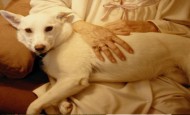What makes human hypochondriacs so odd and disturbing is that they really do believe that they are suffering from an illness in spite of all evidence to the contrary. Canine hypochondriacs are in many ways far more innocent. They have simply learned that certain actions are rewarded, and behave accordingly. Given the inventive repertoire of behavior that dogs are capable of thanks to their playful propensities, and given how strong a drive social attention is for a dog, they are adept at forming such associations in their minds and sticking with them.{+++}
 Dogs that have been genuinely sick and who get a lot of attention as a result are the prime candidates for the “sick pet syndrome.” They can quickly discover that when sitting quietly or acting normally they are ignored, but if they suffer a sudden relapse of an alarming symptom, their owner immediately rushes over, pets them, makes concerned cooing sounds, and so on.
Dogs that have been genuinely sick and who get a lot of attention as a result are the prime candidates for the “sick pet syndrome.” They can quickly discover that when sitting quietly or acting normally they are ignored, but if they suffer a sudden relapse of an alarming symptom, their owner immediately rushes over, pets them, makes concerned cooing sounds, and so on.
Dogs that suffer gastric upheavals, as all dogs do, often get extra attention and sometimes special food. It doesn’t take long for certain dogs to learn that bouts of vomiting and diarrhea are rewarded with hamburger and rice dinners, while behaving normally results in the same old dry dog food. Dogs have acquired such imaginary ailments as lameness, paralysis, muscle twitches, and runny noses, among others.
The surefire test for whether a dog is faking an illness is to leave the house and then sneak back and peek through a window to watch what the dog does when no one is around to provide the immediate reward of attention.
Many alarmed owners, concerned that their pets are suffering from some horrible disease, who refuse to believe that it could just be an act, quickly become converted when they see their lame or paralyzed dogs get up and prance around the house when they think no one is there.
The solution, once it is clear that it is an act rather than a true illness, is simply to ignore the dog whenever he is performing his routine, and to pet him and give him extra attention and food treats whenever he is acting normally, or even just lying quietly. This exactly reverses the previous reinforcement schedule, under which the dog was rewarded for acting goofy and ignored for being normal.
It might seem that a dog that can put on an act only when it has an audience must have some ability to understand the mental state of its audience, a conclusion that seems at odds with the experimental evidence that dogs lack a “theory of mind” and an ability to imagine what others are thinking, perceiving, and feeling. But most likely the dogs in these cases have learned a fairly simple association.
Dogs that seek attention seek that attention from a human, so the presence of a human is the stimulus for its learned behavior. This is no different from a dog that learns to jump up on a bag of dog food – it is the simple presence of an object associated with a reward that is the trigger for the behavior.
A dog does not have to grasp the idea that another being is watching and interpreting his actions; all he has to learn is that taking such an action when a person is present results in a reward – and doing it when no one is present does not.